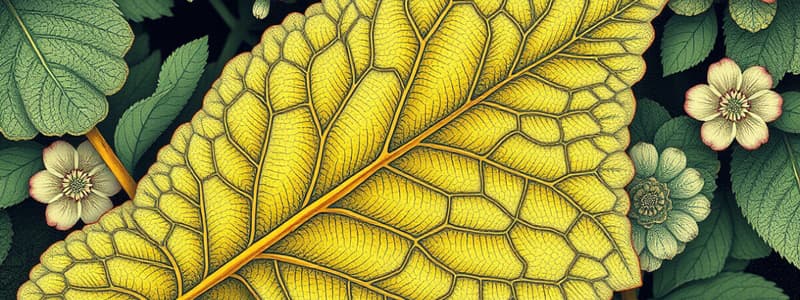Podcast
Questions and Answers
What is the primary function of leaves in vascular plants?
What is the primary function of leaves in vascular plants?
- To absorb water from the soil
- To anchor the plant to the ground
- To conduct photosynthesis (correct)
- To store nutrients
How do leaves minimize water loss while allowing gas exchange?
How do leaves minimize water loss while allowing gas exchange?
- By opening stomata constantly
- By developing deep roots
- By having a thin cuticle
- By using guard cells to control stomata (correct)
What role does the cuticle play in leaf structure?
What role does the cuticle play in leaf structure?
- It prevents water loss (correct)
- It helps the leaf absorb water
- It allows photosynthesis to occur
- It assists in gas exchange
What happens to photosynthesis when the stomata are closed?
What happens to photosynthesis when the stomata are closed?
In what type of environment would you expect leaves to have a thicker cuticle?
In what type of environment would you expect leaves to have a thicker cuticle?
What is transpiration in the context of leaves?
What is transpiration in the context of leaves?
Dicot leaves are characterized by what type of vein structure?
Dicot leaves are characterized by what type of vein structure?
What are stomata primarily responsible for in leaves?
What are stomata primarily responsible for in leaves?
What is the primary function of leaves in vascular plants?
What is the primary function of leaves in vascular plants?
How do leaves help minimize water loss?
How do leaves help minimize water loss?
What is the role of stomata in leaves?
What is the role of stomata in leaves?
What is transpiration, and why is it important for leaves?
What is transpiration, and why is it important for leaves?
Why do stomata close during water stress?
Why do stomata close during water stress?
Which of the following describes the cuticle on a leaf?
Which of the following describes the cuticle on a leaf?
What distinguishes dicot leaves from other types of leaves?
What distinguishes dicot leaves from other types of leaves?
What happens when the stomata are open?
What happens when the stomata are open?
Flashcards are hidden until you start studying
Study Notes
Overview of Leaves
- All three groups of vascular plants possess leaves, crucial for photosynthesis.
- Leaves are the primary site for photosynthesis, while also being the most susceptible to water loss via stomata.
- Water is essential for plant survival, influencing leaf characteristics such as size and shape, which are often evolutionary adaptations.
Leaf Structure and Functions
- Leaves aim to maximize photosynthetic surface area while minimizing water loss, leading to diverse appearances across species.
- The cuticle, a waxy layer on most leaves, prevents water loss and offers protection against insects.
- Cuticle thickness varies: thicker in hot, dry climates, thinner in cool, damp areas.
Gas Exchange and Transpiration
- Cuticle's impervious nature prevents water and gases from entering or leaving the leaf, creating a challenge for photosynthesis.
- Stomata are openings that facilitate gas exchange, allowing CO₂ in for photosynthesis and releasing O₂ and water vapor.
- Photosynthesis reaction: Sunlight + 6CO₂ + 6H₂O → C₆H₁₂O₆ + 6O₂.
Stomatal Function
- Stomata can be located on one or both leaf surfaces and play a crucial role in gas exchange.
- Transpiration occurs when water vapor exits leaves, helping cool them down.
- In water-stressed conditions, stomata close to conserve water, impacting photosynthesis due to reduced CO₂ availability.
Regulation by Guard Cells
- Guard cells flank each stoma; they regulate its opening and closing to manage water loss.
- Open stomata allow O₂ to escape; however, this can lead to enzyme inhibition if O₂ accumulates.
- Closed stomata slow down or halt photosynthesis due to insufficient CO₂ while preventing excessive water loss, which is vital for plant health.
Leaf Types and Structures in Angiosperms
- Dicot leaves exhibit reticulate (web-like) vein patterns, aiding in efficient nutrient transport and structural support.
- Upon fertilization, leaves contribute to seed development, completing the plant's reproductive cycle.
Studying That Suits You
Use AI to generate personalized quizzes and flashcards to suit your learning preferences.




